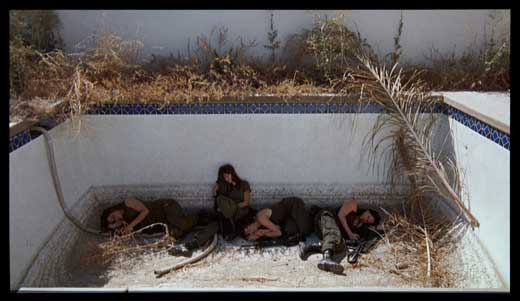Boston’s Best
Boston tends to have an inferiority complex when it comes to art. One of the world’s great college towns, it’s a great place to learn to be an artist, but not always a great place to pursue a career in art, existing as it does in the long shadow of New York City, one of […]

Amie Siegel, Black Moon, 2010, Super-16mm film transferred to High Definition 20 minutes, color/sound. Courtesy of the artist.
Boston tends to have an inferiority complex when it comes to art. One of the world’s great college towns, it’s a great place to learn to be an artist, but not always a great place to pursue a career in art, existing as it does in the long shadow of New York City, one of the international capitals of the art world.
Living up here in Maine, it sometimes seems to me that there are as many good art galleries and museums in the state as there are in Boston. Artists have told me that they tend to skip over Boston when looking to exhibit their work because it takes just as much effort to land a show in Boston as it does one in New York, which is where you really want to be as an artist.
In recent years, Boston Phoenix art critic Greg Cook has been examining the Boston art inferiority complex on his award-winning art blog The New England Journal of Aesthetic Research, arguing in favor of “Yokelism” while charging that museums and the media don’t pay enough serious attention to Boston artists.
Cook himself organized the Boston Art Awards, now expanded as the New England Art Awards, to recognize the best of local art, artists, and exhibitions, so you’d think he’d be thrilled that, since 1999, the Institute of Contemporary Art/Boston has given a biennial James and Audrey Foster Prize in order “to nurture and recognize Boston-area artists of exceptional promise.” Cook, however, tends to think the Foster Prize is condescending, a bone thrown every two years to local artists who are ignored most of the time.
“The Foster Prize’s real problem is vision,” wrote Cook on October 5. “The ICA folks act as if the prize were a finishing school that they run as a charity for local schlubs they’re embarrassed to be seen with. Listen for the maternalistic tone when ICA director Jill Medvedow says that the show offers local artists ‘experiences that they might not have had before, which is getting to work with museum curators.’ If the show is meant as a launching pad, the ICA might want to examine why for many past winners it has seemed more of a dead end.”
Boston Globe art critic Sebastian Smee was hardly more enthusiastic about the 2010 Foster Prize when, on September 24, he wrote, “The 2008 James and Audrey Foster Prize at the Institute of Contemporary Art was an almighty yawn. This year, the biennial event, which aims to ‘showcase’ and ‘celebrate’ neglected Boston-area artists, is much better.”
In 2008, the ICA’s Foster Prize exhibition featured just four artists. This year, the ICA jury selected nine Boston-area artists to show in the Foster Prize exhibition (September 22 to January 17). The winner of the $25,000 Foster prize will be announced in December.
The 2010 Foster Prize exhibition highlights the intellectual/academic nature of the Boston art scene. Five of the nine finalists are on the faculty of Massachusetts College of Art and Design – sculptor Robert de Saint Phalle, photographer Eirik Johnson, Fred H.C. Liang, who uses traditional Chinese cut paper in multimedia art, photo-artist Evelyn Rydz, and photographer Steve Tourlentes. Filmmaker Rebecca Meyers teaches at Emerson College. Painter Matthew Rich teaches at Northeastern University. Painter Daniela Rivera teaches at Wellesley College. And filmmaker Amie Siegel teaches at Harvard.
Greg Cook is betting on Siegel to win the Foster Prize for her surreal 20-minute art film Black Moon. His second choice is Rich for his cut paper abstractions. Cook dismisses the rest of the show as “unremarkable.” Sebastian Smee likes Rebecca Meyers’ four-minute, 16-mm film night side best, but dismisses art prizes as “inherently silly.”
True enough, art should not be a form of competition. But since the Red Sox did not even make the playoffs, let alone the World Series, the battle for the Foster Prize will have to do.
(Institute of Contemporary Art/Boston, 100 Northern Ave., Boston MA, 617-478-3100.)
Edgar Allen Beem
Take a look at art in New England with Edgar Allen Beem. He’s been art critic for the Portland Independent, art critic and feature writer for Maine Times, and now is a freelance writer for Yankee, Down East, Boston Globe Magazine, The Forecaster, and Photo District News. He’s the author of Maine Art Now (1990) and Maine: The Spirit of America (2000).
More by Edgar Allen Beem

